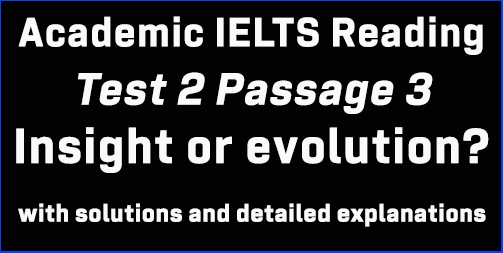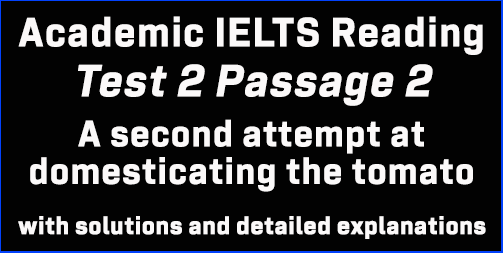IELTS Academic Reading: Cambridge 15 Test 2 Reading passage 1; Could urban engineers learn from dance?; with best solutions and best explanations
This Academic IELTS Reading post focuses on solutions to IELTS Cambridge 15 Reading Test 2 Reading Passage 1 entitled ‘Could urban engineers learn from dance?’. This is a targeted post for IELTS candidates who have big problems finding out and understanding Reading Answers in the AC module. This post can guide you the best to understand every Reading answer without much trouble. Finding out IELTS Reading answers is a steady process, and this post will assist you in this respect.
IELTS Cambridge 15 Test 2: AC Reading Module
Reading Passage 1: Questions 1-13
The headline of the passage: Could urban engineers learn from dance?
Questions 1-6: Identifying information
[This question asks you to find information from the passage and write the number of the paragraph (A, B, C or D … .. ) in the answer sheet. Now, if the question is given in the very first part of the question set, I’d request you not to answer them. It’s mainly because this question will not follow any sequence, and so it will surely kill your time. Rather, you should answer all the other questions first. And just like List of Headings, only read the first two lines or last two lines of the expected paragraph initially. If you find the answers, you need not read the middle part. If you don’t find answers yet, you can skim the middle part of the paragraph. Keywords will be a useful matter here.]
Question no. 1: reference to an appealing way of using dance that the writer is not proposing
Keywords for the question: appealing way, using dance, writer not proposing,
The answer can be found in the first line of paragraph B, “Dance might hold some of the answers. That is not to suggest everyone should dance their way to work, however healthy and happy it might make us, … . .”
Here, That is not to suggest = the writer is not proposing, healthy and happy it might make us = an appealing way,
So, the answer is: B
Question no. 2: an example of a contrast between past and present approaches to building
Keywords for the question: example, contrast, past and present approaches, building,
Lines 1-4 of paragraph C say, “Whereas medieval builders improvised and adapted construction through their intimate knowledge of materials and personal experience of the conditions on a site, building designs are now convinced and stored in media technologies that detach the designer from the physical and social realities they are creating. … . ..”
Here, medieval = past builders, building designs are now = building designs of present time,
The word ‘Whereas’ at the beginning of the sentence indicates that the writer is showing a comparison here.
So, the answer is: C
Question no. 3: mention of an objective of both dance and engineering
Keywords for the question: an objective, both, dance, engineering,
In lines 2-6 of paragraph F, the writer mentions, “ .. . . In order to bring about fundamental changes to the ways we use our cities, engineering will need to develop a richer understanding of why people move in certain ways, and how this movement affects them. Choreography may not seem an obvious choice for tackling this problem. Yet it shares with engineering the aim of designing patterns of movement within limitations of space. .. ..”
Here, it shares with engineering = an objective of both dance and engineering,
So, the answer is: F
Question no. 4: reference to an unforeseen problem arising from ignoring the climate
Keywords for the question: an unforeseen problem, arising from, ignoring the climate,
Read the middle part of paragraph D. In lines 5-7, the writer states, “ . .. . They failed to take into account that purpose-build street cafés could not operate in the hot sun without the protective awnings common in older buildings, .. . .”
Here, They failed to take into account = ignoring, purpose-build street cafés could not operate = unforeseen problem, the hot sun = the climate,
So, the answer is: D
Question no. 5: why some measures intended to help people are being reversed
Keywords for the question: why, measures, intended to help people, reversed,
In paragraph E, lines 1-4 say, “The same is true in transport engineering, which uses models to predict and shape the way people move through the city. Again, these models are necessary, but they are built on specific world views in which certain forms of efficiency and safety are considered and other experiences of the city ignored. Designs that seem logical in models appear counter-intuitive in the actual experience of their users. … ..”
Here, appear counter-intuitive = appear to reverse,
These lines clearly suggest that some measures which may seem logical in models may become illogical when appear in the actual experience.
So, the answer is: E
Question no. 6: reference to how transport has an impact on human lives
Keywords for the question: how, transport has, impact, human lives,
Lines 5-7 in paragraph A talks about the impact of transport in human lives. The writer says here, “. .. . The ways we travel affect our physical and mental health, our social lives, our access to work and culture, and the air we breathe. .. ..”
Here, The ways we travel = transports, affect = has an impact,
So, the answer is: A
Questions 7-13: Summary completion
[In this kind of question candidates are given a summary for one, two or three paragraphs with some fill in the blanks questions. Candidates need to find out the related paragraphs by correctly studying the keywords form the questions. Then, they should follow the steps of finding answers for fill in the gaps.]
Title of the summary: Guard rails
The summary of the title indicates that we have to look for the answers in paragraph E.
Question no. 7 & 8: Guard rails were introduced on British roads to improve the 7. _______ of pedestrians, while ensuring that the movement of 8. ______ is not disrupted.
Keywords for the question: guard rails, introduced, British roads, improve, pedestrians, ensuring, movement of, not disrupted,
In lines 5-7 of paragraph E, the author of the passage says, “ . . . The guard rails that will be familiar to anyone who has attempted to cross a British road, for example, we an engineering solution to pedestrian safety based on models that prioritise the smooth flow of traffic. . .. .”
Here, solution = improve, smooth flow = movement . .. . not disrupted,
So, the answers are:
- safety
- traffic
Question no. 9: Pedestrians are led to access points, and encouraged to cross one ______ at a time.
Keywords for the question: pedestrians, led to access points, encouraged, cross, one, at a time,
In paragraph E, the author states in lines 8-10, “ . . . On wide major roads, they often guide pedestrians to specific crossing points and slow down their progress across the road by using staggered access points to divide the crossing into two – one for each carriageway. . . .”
Here, they often guide pedestrians . .. . using staggered access points = pedestrians are led to access points, one for each carriageway = one carriageway at a time,
So, the answer is: carriageway
Question no. 10: An unintended effect is to create psychological difficulties in crossing the road, particularly for less _______ people.
Keywords for the question: unintended effect, create, psychological difficulties, crossing the road, particularly, less, people,
If we look at paragraph E, we can see that the writer says in lines 10-11, “. .. .. . In doing so they make crossings feel longer, introducing psychological barriers greatly impacting those that are the least mobile, . … . .”
Here, they make crossings feel longer = An unintended effect, introducing = create, psychological barriers = psychological difficulties, the least = less,
So, the answer is: mobile
Question no. 11: Another result is that some people cross the road, in a ______ way.
Keywords for the question: another result, some people, cross the road, way,
Lines 11-12 of paragraph E say, “ . . . and encouraging others to make dangerous crossings to get around the guard rails. . .. .”
Here, and = Another result, others = some people, crossings = cross the road,
So, the answer is: dangerous
Question no. 12: The guard rails separate _______, . .. . .
Keywords for the question: guard rails, separate,
In paragraph E, the writer says in lines 12-13, “ . .. These barriers don’t just make it harder to cross the road: they divide communities .. .. .”
Here, These barriers = The guard rails, divide = separate,
So, the answer is: communities
Question no. 13: . . . .and make it more difficult to introduce forms of transport that are _______.
Keywords for the question: make, more difficult, introduce, forms of transport,
Lines 13-14 in paragraph E say, “. … and decrease opportunities for healthy transport, . .. .. .”
Here, make it more difficult = decrease, opportunities = introduce,
So, the answer is: healthy
Click here for solutions to Cambridge 15 Test 2 Reading passage 2
Click here for solutions to Cambridge 15 Test 2 Reading passage 3




Hello
Dance and building
Dear, I find it confusing in the first question why the answer is not G. We have “appealing way of using way”=”This kind of physical knowledge is valued” ” not proposing” =”had no place” I do not totally understand. Thank for your time.
Good